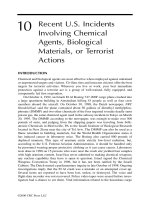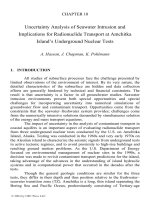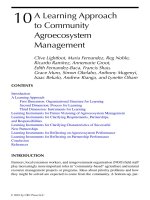Employee training and development 5th chapter 10
Bạn đang xem bản rút gọn của tài liệu. Xem và tải ngay bản đầy đủ của tài liệu tại đây (420.16 KB, 34 trang )
Chapter 10
Special Issues in Training and Employee
Development
McGraw-Hill/Irwin
Copyright © 2010 by the McGraw-Hill Companies, Inc. All rights reserved.
Table 10.1 - Situations That may
Result in Legal Action
8-2
Training Issues Resulting From the
External Environment
Cross-cultural preparation - involves educating
employees (expatriates) and their families who are to be
sent to a foreign country.
Expatriates - people who work in a country other than
their country of origin.
8-3
Table 10.2 - Types of Employees
in Global Companies
8-4
Training Issues Resulting From the
External Environment (cont.)
G. Hofstede identified five dimensions of national culture:
Individualism-collectivism
Uncertainty avoidance
Masculinity-femininity
Power distance
Time orientation
8-5
Training Issues Resulting From the
External Environment (cont.)
To be successful in overseas assignments, expatriates
need to be:
Competent in their area of expertise.
Able to communicate verbally and nonverbally in the
host country.
Flexible, tolerant of ambiguity, emotionally stable,
outgoing and agreeable, and sensitive to cultural
differences.
8-6
Training Issues Resulting From the
External Environment (cont.)
To be successful in overseas assignments, expatriates
need to be:
Motivated to succeed, able to enjoy the challenge of
working in other countries, and willing to learn about
the host country’s culture, language, and customs.
Supported by their families.
8-7
Training Issues Resulting From the
External Environment (cont.)
Key to successful foreign assignment is a combination of
training and career management for employees and their
families.
Foreign assignments involve three phases:
Pre-departure phase
On-site phase
Repatriation phase
8-8
Training Issues Resulting From the
External Environment (cont.)
Pre-departure phase
Employees need to receive language training and an
orientation in the new country’s culture and customs;
the family should be included in the orientation.
Expatriates and their families need information about
the various facilities in the area where they will live.
Employees must discuss with their managers how the
foreign assignment fits into their career plans and what
type of position they can expect upon return.
8-9
Figure 10.2 - Relationship Between
Training Methods and Training Rigor
8-10
Training Issues Resulting From the
External Environment (cont.)
On-site phase
Training involves continued orientation to the host
country and its customs and cultures through formal
programs or through a mentoring relationship.
Expatriates and their families may be paired with a
mentor from the host country who helps them
understand the new, unfamiliar work environment and
community.
8-11
Training Issues Resulting From the
External Environment (cont.)
Repatriation phase
Prepares expatriates for return to the parent company
and country from the foreign assignment.
Expatriates and their families are likely to experience
high levels of stress and anxiety when they return
because of the changes that have occurred since their
departure.
Expatriates decide to leave the company because the
assignment they are given upon return has less
responsibility, challenges, and status than the foreign
assignment.
8-12
Training Issues Resulting From the
External Environment (cont.)
Virtual expatriates - an operation abroad are assigned
to manage without being located permanently in that
country.
Allows the employee to manage globally while keeping
in close touch with the home office.
Are less expensive.
Expatriates may take longer to solve problems because
of the lack of a strong personal relationship with local
employees.
8-13
Table 10.4 - Implications of Cultural
Dimensions for Training Design
8-14
Training Issues Resulting From the
External Environment (cont.)
Managing work force diversity
The goals of diversity training are:
To eliminate values, stereotypes, and managerial
practices that inhibit employees’ personal
development.
To allow employees to contribute to organizational
goals regardless of their race, age, physical
condition, sexual orientation, gender, family status,
religious orientation, or cultural background.
8-15
Training Issues Resulting From the
External Environment (cont.)
Managing work force diversity
Managing diversity - creating an environment that
allows all employees to contribute to organizational
goals and experience personal growth.
This includes access to jobs and fair and positive
treatment of all employees.
8-16
Table 10.5 - How Managing Diversity
can Provide a Competitive Advantage
8-17
Figure 10.3 - Cycle Of Disillusionment That Results
From Managing Diversity Through Adherence to
Legislation
8-18
Training Issues Resulting From the
External Environment (cont.)
To successfully manage a diverse work force, companies
need to ensure that:
Employees understand how their values and
stereotypes influence their behavior toward people of
different gender, ethnicity, race, or religion.
Employees gain an appreciation of cultural differences
among themselves.
Behaviors that isolate or intimidate minority group
members improve.
8-19
Training Issues Resulting From the
External Environment (cont.)
Attitude awareness and change programs
Focus on increasing employees’ awareness of
differences in cultural and ethnic backgrounds, physical
characteristics, and personal characteristics that
influence behavior toward others.
The assumption is that by increasing awareness of
stereotypes and beliefs, employees will be able to
avoid negative stereotypes when interacting with
employees of different backgrounds.
8-20
Training Issues Resulting From the
External Environment (cont.)
Behavior-based programs
Focus on changing the organizational policies and
individual behaviors that inhibit employees’ personal
growth and productivity.
Approaches:
Identify incidents that discourage employees from
working up to their potential.
Teach managers and employees basic rules of
behavior in the workplace.
Cultural immersion - sending employees directly
into communities where they have to interact with
persons from different cultures, races, and/or
nationalities.
8-21
Table 10.6 - Characteristics Associated with
Diversity Programs’ Long-Term Success
8-22
Table 10.7 - Key Components of Effective
Managing Diversity Programs
8-23
Table 10.7 - Key Components of Effective
Managing Diversity Programs
8-24
Training Issues Resulting From the
External Environment (cont.)
School-to-work transition programs - combine
classroom experiences with work experiences to prepare
high school students for employment.
School-to-Work Opportunities Act -designed to assist
the states in building school-to-work systems that prepare
students for high-skill, high-wage jobs or future education.
8-25









